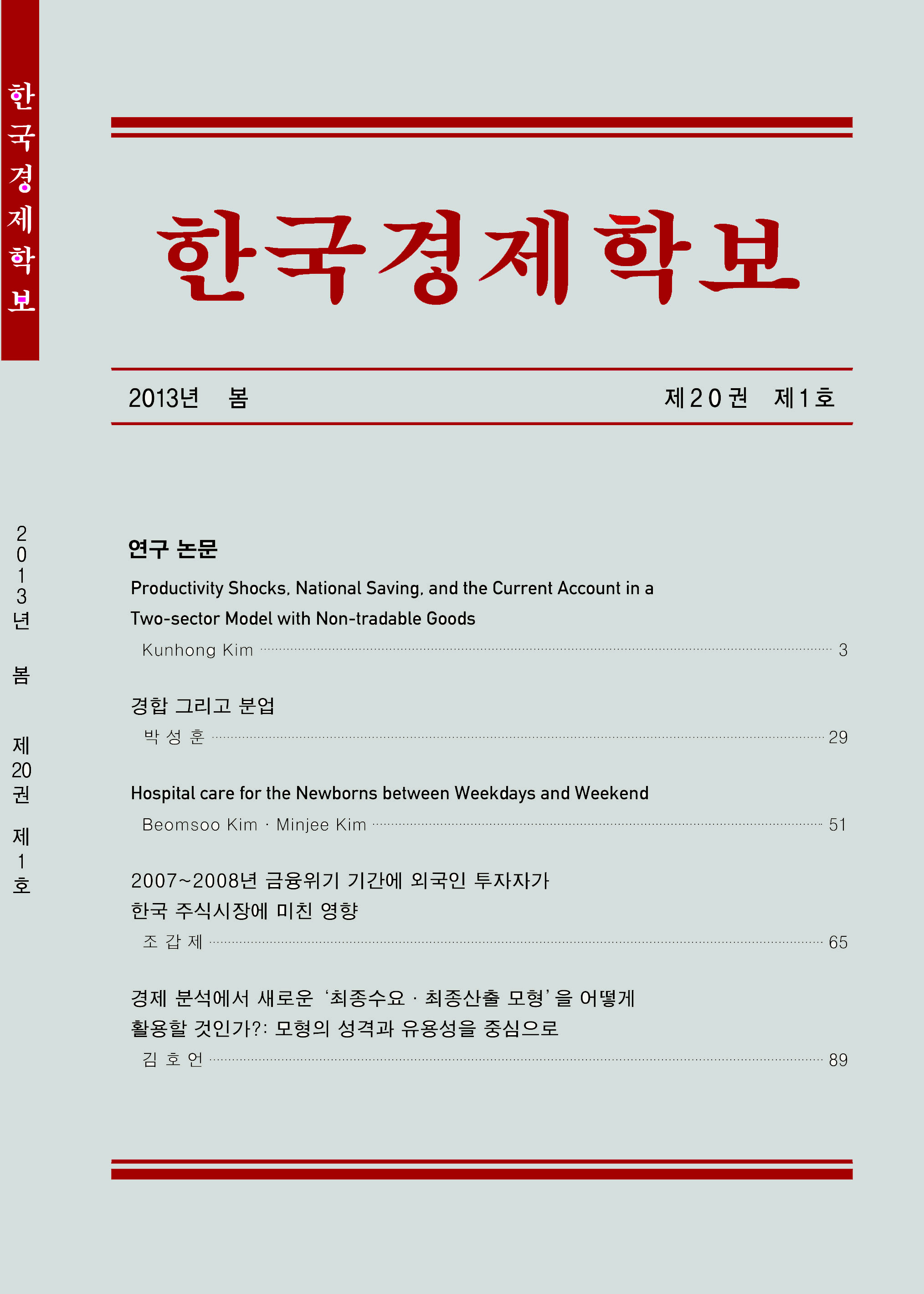
한국경제학보 제 29권, 제 1호 (2022년 봄)
우대형
Pages 3-52
-
Abstract ( Eng | Kor ) || PDF
- A Reexamination of the Grain Market Integration in Korea, 1743~1910
Dae Hyung Woo
This paper uses an Error Correction Model on annual and
semiannual grain prices to examine the extent and degree of
market integration of Korea in 1743~1910. According to our
results, not only was the grain market between metropolitan Seoul
and the local markets integrated from at least the mid-18th
century, but also rural areas had achieved integration into a single
market. Furthermore, the degree of integration between Seoul and
rural areas was found to be higher than the integration between
rural areas, which indicates that Seoul as a commercial city led
market integration at the national level. Like the rice market, the
soy market was also an integrated single market and was never far
behind the rice market in terms of its qualitative degree of
integration. On the other hand, there were no signs that the grain
market was splitting or dissolving after the mid-19th century.
Instead, the coefficient of price variation between markets shows
that market efficiency had increased steadily since the mid-18th
century. Finally, this study compared the estimated error
correction coefficient of late Joseon with that of Western European
cities before the Industrial Revolution. It found that degree of
market integration in late Joseon had reached a stage equivalent
to that of the major Western European cities on the eve of the
Industrial Revolution.
- 본 논문은 조선 후기 서울의 明禮宮과 각 지역의 兩班家에서 작성한 곡물
가격 시계열자료를 활용하여, 개항(1876) 이전 곡물시장의 통합 범위와
그 수준을 살펴보기 위해 작성되었다. 오차수정모형(error correction
model)을 사용한 본 연구의 추정결과에 따르면, 조선의 곡물시장은 늦어
도 18세기 중엽이후부터 서울과 농촌간은 물론이고 각 농촌 간에도 하나
의 단일시장으로 통합되어 있었다. 또한 서울과 농촌 간의 통합 수준이 각
농촌 간의 통합 수준보다 높은 것으로 나타나, 상업 도시로서의 서울이 전
국적 규모의 시장통합을 주도하였음도 알 수 있었다. 두류시장 역시 미곡
시장과 마찬가지로 통합된 단일시장을 이루고 있었으며, 통합의 질적 수준
도 미곡시장에 결코 뒤지지 않는 것으로 나타났다. 한편 19세기 중엽 이
후에 곡물시장이 분열과 해체되었음을 보여주는 어떠한 징후도 발견되지
않았으며, 오히려 각 시장 간의 가격 격차(price dispersion)를 나타내
는 변동계수의 추이에 따르면, 곡물시장의 통합 강도는 시간이 지날수록
점점 더 강화되고 있었다. 마지막으로 본 논문에서 추정된 오차수정계수를
산업혁명 이전 서유럽 대도시를 대상으로 한 오차수정계수와 비교해본 결
과, 조선 후기 곡물시장의 통합 수준은 산업혁명 직전 서유럽과 맞먹을 만
큼 높은 단계에 도달한 것으로 나타났다.
김봉근, 이지홍, 이철인
Pages 53-83
-
Abstract ( Eng | Kor ) || PDF
- The Effects of Labor Union on Innovation:Patent and Workplace Panel Analysis
Bonggeun Kim, Jihong Lee, Chul-In Lee
This study analyzes the impact of labor unions on corporate
innovation strategy and performance using Korean data from
Workplace Panel Survey and Korea Patent Data Project. Our panel
analysis reveals no significant correlation between the presence of
labor union and international patenting as well as quantitative
and qualitative innovation indicators. In contrast, firms with
favorable industrial relations show improvement in innovation
indicators after the establishment of a union. Our results suggest
that detailed information on industrial relations is important for
understanding the effects of labor union on corporate innovation.
- 본 연구는 2005-2017년 사업체패널조사와 한국 특허 데이터 프로젝트
(KoPDP) 자료를 이용하여 기업의 노동조합이 미국특허시장 진출 전략과
장기적 혁신 역량에 미치는 영향을 분석한다. 우리나라 전체 기업별 기업
혁신 역량을 분석할 수 있도록 구축된 KoPDP 자료와 제조업체들의 노사
관계에 관한 대표적인 패널자료인 사업체패널을 최초로 결합하여 두 자료
의 활용도 증진을 모색하고, 결합자료의 다양한 변수 및 개선된 종단면분
석 방법론의 적용을 통해 기존 노조의 혁신 역량분석의 영역을 확대한다.
종단분석의 결과 기존 문헌과는 달리 노동조합의 유무가 기업의 미국특허
시장 진출 여부나 양적?질적 혁신 지표와는 유의한 상관관계가 없는 것으
로 드러난다. 유노조기업은 미국시장 진출이 장기적 혁신역량에 미치는 영
향 측면에서도 무노조기업과 유의미한 차이가 없다. 한편 노사관계가 우호
적인 기업은 비우호적인 기업에 비해 노조 설립을 전후하여 혁신 지표가
개선되는 것으로 나타난다. 이러한 세부적인 이질성은 노동조합 관련 연구
를 진행함에 있어 노사관계에 대한 세밀한 정보가 중요함을 시사한다.
Karen Meng Li
Pages 85-115
-
Abstract ( Eng | Kor ) || PDF
- The Illusion of Knowing: Households’Misplaced Confidence and Stock Market Participation
Karen Meng Li
This paper exploits CHFS2017’s household data to study misplaced
confidence when perception deviates from objective financial
knowledge. Observing the relationship between “misplaced
confidence” and stock market participation and net worth, I explain
the mystery of limited stock market participation: misplaced
confidence leads to sub-optimal choices. The study also finds that
the positive correlation between objective financial knowledge and
stock market participation is affected by threshold effects.
- 이 논문은 CHFS2017의 가계 데이터를 사용하여 본인의 금융지식에 대한
주관적 평가가 객관적인 금융지식 수준과 다를 때 나타나는 잘못된 자신감을
연구한다. 더 구체적으로 잘못된 자신감과 주식시장 참여 및 순자산 간의 관
계를 분석해서 중국인들의 주식시장 참여가 제한적인 이유를 밝혀냈다. 또한
객관적 금융지식과 주식시장 참여 사이의 양의 상관관계에서 ‘임계치 효과’가
나타난다는 것도 발견했다.
The Korean Journal of Economics, Vol. 29, No. 1 (Spring 2022)


